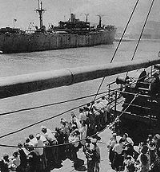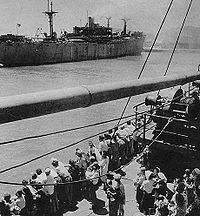
Japanese repatriation from Huludao
Encyclopedia

Northeast China
Northeast China, historically known in English as Manchuria, is a geographical region of China, consisting of the three provinces of Liaoning, Jilin and Heilongjiang. The region is sometimes called the Three Northeast Provinces...
after the end of World War II
World War II
World War II, or the Second World War , was a global conflict lasting from 1939 to 1945, involving most of the world's nations—including all of the great powers—eventually forming two opposing military alliances: the Allies and the Axis...
in 1945. In this operation, done by the American forces' ships under the auspices of the Republic of China
Republic of China
The Republic of China , commonly known as Taiwan , is a unitary sovereign state located in East Asia. Originally based in mainland China, the Republic of China currently governs the island of Taiwan , which forms over 99% of its current territory, as well as Penghu, Kinmen, Matsu and other minor...
government, over one million Japanese were carried back to their homeland, from 1946 to 1948.
General description
Immediately after the end of World War IIWorld War II
World War II, or the Second World War , was a global conflict lasting from 1939 to 1945, involving most of the world's nations—including all of the great powers—eventually forming two opposing military alliances: the Allies and the Axis...
in August, 1945, about 1.5 million Japanese people were left in China
China
Chinese civilization may refer to:* China for more general discussion of the country.* Chinese culture* Greater China, the transnational community of ethnic Chinese.* History of China* Sinosphere, the area historically affected by Chinese culture...
, the largest majority of which were in Northeast China
Northeast China
Northeast China, historically known in English as Manchuria, is a geographical region of China, consisting of the three provinces of Liaoning, Jilin and Heilongjiang. The region is sometimes called the Three Northeast Provinces...
, mostly farmers and merchants. Some of the able-bodied men among them were being sent by the Soviet forces to Siberia for forced labor
Japanese prisoners of war in the Soviet Union
By the end of :World War II there were from 560,000 to 760,000 Japanese POWs in the Soviet Union and Mongolia interned to work in labor camps. Of them, about 10% died , mostly during the winter of 1945–1946....
and still other engineers and medical doctors were beginning to be asked for cooperation by the Chinese Communist forces.
To this situation, the Japanese government did almost nothing in the confusion right after the defeat of the war. Three young men from Anshan (Kunio Maruyama, Hachiro Shimpo and Masamichi Musashi) volunteered to report this situation to Japan, who escaped from Manchuria and met with the Japanese government in Tokyo. They later met with General Douglas MacArthur
Douglas MacArthur
General of the Army Douglas MacArthur was an American general and field marshal of the Philippine Army. He was a Chief of Staff of the United States Army during the 1930s and played a prominent role in the Pacific theater during World War II. He received the Medal of Honor for his service in the...
, then the head of the Allied Occupation Forces, who immediately decided on the Japanese repatriation from Huludao. The American forces which were assisting the Chinese Nationalist
Chinese nationalist
Chinese nationalist can refer to:* Chinese nationalism* Kuomintang - Chinese Nationalist Party in Taiwan....
government sensed this dangerous situation and sent ships on a tripartite operation to:
- carry Chinese soldiers from Southern ChinaNorthern and southern ChinaNorthern China and southern China are two approximate regions within China. The exact boundary between these two regions has never been precisely defined...
to north in Huludao, for reinforcement - repatriate Japanese to Hakata Port, Fukuoka City, Japan
- transport to China the Chinese people who had worked in Japan mostly under forced labor
Huludao
Huludao
Huludao is a prefecture-level city in southwestern Liaoning Province, China. It is one of the two principal cities in the Liaoxi Corridor . Known as Jinxi until 1994, Huludao has a total area of 10,415 square kilometers and a population of 2.87 million, of which some 531,000 live in the city proper...
in Liaoning
Liaoning
' is a province of the People's Republic of China, located in the northeast of the country. Its one-character abbreviation is "辽" , a name taken from the Liao River that flows through the province. "Níng" means "peace"...
Province at that time was the only strategic seaport and corridor to Northeast China, held by the Nationalist forces, which were battling against the Chinese Communist forces for the control of Northest China.
From May 7, 1946, when this operation began, till August, 1948, when it ended as Huludao was under pressure from the Communist forces, about 1,050,000 Japanese people were repatriated. Many had died in Haerbin, Changchun
Changchun
Changchun is the capital and largest city of Jilin province, located in the northeast of the People's Republic of China, in the center of the Songliao Plain. It is administered as a sub-provincial city with a population of 7,677,089 at the 2010 census under its jurisdiction, including counties and...
, Shenyang
Shenyang
Shenyang , or Mukden , is the capital and largest city of Liaoning Province in Northeast China. Currently holding sub-provincial administrative status, the city was once known as Shengjing or Fengtianfu...
during the 1945-46 winter before this operation began. Those who reached Huludao in the worst conditions, but died there, were buried in the nearby Cishan mountain , in their simplest tombs facing east, towards the direction of their homeland.
A stele commemorating this event in the Sino-Japanese history stands on the seaport in Huludao. It cannot be easily visited because its location is in the restricted area, due to Huludao being a strategic submarine base in China.

